Why a gas stove with a propane cylinder smokes: main breakdowns and recommendations for troubleshooting
Gas equipment provides comfort when cooking and is quite easy to use.And the cost of energy is affordable. Where there is a centralized gas supply, there are no difficulties with fuel supply. In small settlements and dacha cooperatives there are no central networks; the population uses cylinders to provide power to gas appliances.
The quality of bottled gas is somewhat different from that supplied centrally, and stove owners may notice that the burners are not working correctly. When figuring out why a gas stove smokes, it’s worth considering that not all faults can be fixed on your own. In most cases, the assistance of a qualified specialist will be required.
In this article we will talk about the main causes of soot and options for eliminating the breakdown. We also note in which cases you should immediately contact specialists.
The content of the article:
Main causes of soot
The gas stove operates normally if the flame in the burner is a natural blue color, without any red and/or yellow tint. When multi-colored tongues appear in the flame, the gas is supplied unevenly, then such work cannot be called correct. A reddish tint to the flame indicates that the fuel is not completely burned or there is not enough air to burn the gas.
The presence of red flames often precedes the appearance of soot.
The cause of this unpleasant phenomenon is considered to be:
- low gas quality;
- high/low blood pressure.
When the gas mixture contains too much mercaptan sulfur, thick, black smoke appears, the particles of which settle on the dishes and walls of the room.
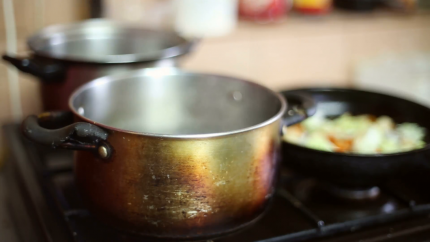
A similar situation occurs when the stove is connected to a low-quality cylinder with a low gas content. In some cases, soot appears when there is a malfunction of the burner itself.
Let's look at the main reasons in more detail.
Reason #1 - low fuel quality
When understanding why soot appears from a working gas stove, it is important to know that the cylinders are refilled gas mixture. When the composition has a high sulfur content, soot appears.
If you are absolutely sure that the cause of the soot was poor-quality fuel, you can file a complaint with Rospotrebnadzor and other similar organizations.
Along with the application you will need to provide:
- a receipt issued when refilling the cylinder;
- the tank itself (cylinder) with low-quality fuel for examination.
Often such incidents are resolved peacefully in favor of gas consumers. You don’t know what to do when a gas stove powered by a cylinder smokes and what measures can be taken immediately?
Then remember a simple algorithm:
- try moving the cylinder or gas stove to another place;
- if you have friends who use the services of the same organization that refills cylinders, check whether their gas stove smokes;
- contact your fuel supplier with a request to explain the increased sulfur content in the gas mixture;
- If there is no contact with the organization that refills the cylinders, write a complaint with a request to restore justice and compensate for the cost of property damaged by soot.
When starting a dispute with your fuel supplier, make sure that the problem is gas quality. We also recommend that you familiarize yourself with the requirements for cylinders when refilling and filling standards.
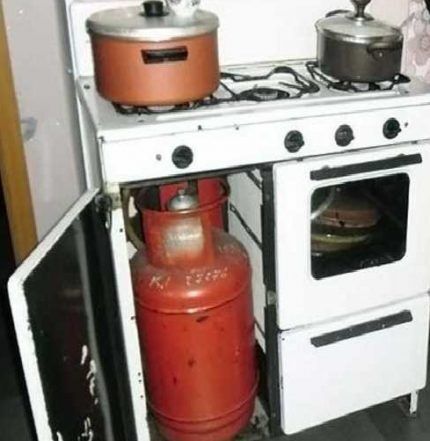
In addition to problems with gas supplies, the cause of soot is often the need to adjust equipment and eliminate malfunctions.
Reason #2 - incorrect stove settings
Understanding why a household gas stove smokes, connected to a propane tank, it is important to assess the pressure level in the system. It depends not only on the quality of the cylinder, but also on the operating features of the burner. To deal with the problem, it is important to know the device of the latter.
The burner consists of the following elements:
- Divider — designed for uniform distribution of fuel along the entire perimeter of the burner. In appearance, the divider resembles a sleeve, which is cut along the contour.
- Divider cover provides the required diameter, looks like a round-shaped lid made of stainless steel, located on the top of the divider.
- Electric spark plug - an element of modern models of gas stoves. The spark is a signal to start work; it ignites the gas. The candle is located on the side of the divider, and a temperature sensor is placed nearby, which ensures safe operation of the stove.If the fire goes out, a command is transmitted to a special electromechanical device,
- Jet located under the divider, it looks like a small bolt with a through axial hole. The injector is responsible for uniform fuel supply and regulates pressure.
The appearance of soot, incorrect operation of the gas stove - all this is often associated with the installed nozzle, or rather, with a hole in it that is too large.
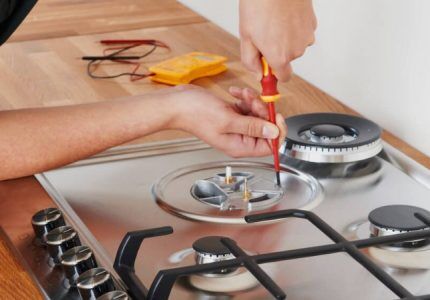
Uneven fuel supply may be due to blockages. To clean the nozzle, you need to carefully insert a thin wire into the hole and twist it between your fingers. It is not recommended to press or pick the jet. This can lead to an enlargement of the hole and the appearance of soot.
If there is dirt, be sure to clean other parts as well, as soot may appear as a result of combustion of deposits that have accumulated on the burner surfaces. Scrub all the elements well with an old toothbrush dipped in detergent. Then rinse the parts under running water and dry well. Only after this proceed to assembling the gas stove.
Reason #3 - insufficient air volume
Insufficient air quantity, which is supplied to the burner, will lead to the appearance of soot even if all other elements are in working order. To adjust the air discs, unscrew the locking screw and act very carefully.
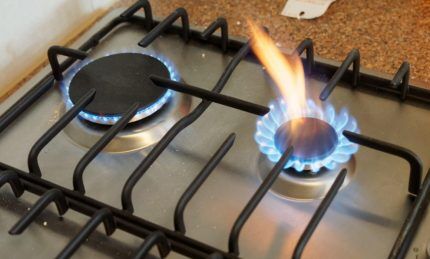
After adjusting the operation of the air discs, you must immediately check the quality of the gas stove.
When the burner is turned on, the gas should burn without any extraneous sounds or buzzing. The flames should not be more than 2.5 cm in height. If the adjustment does not help, you should return the air discs to their original position.
When should you replace an injector?
Modern gas stoves, for the most part, are designed for a centralized gas supply. Methane is used in central networks, system pressure differs from the pressure in the cylinder, so a slightly larger diameter hole in the nozzle is required. When using bottled gas, propane is used to meet household needs, so a nozzle with a smaller hole is required.
The basic configuration always uses injectors designed to supply fuel through centralized lines. Modern models may include a spare nozzle designed for bottled gas. Also, in order to use the cylinders, they additionally have to be replaced gas reducer.
When trying to get rid of the cause of soot on the burner of a household gas stove, it is important to purchase a jet that matches the brand of the household appliance. Otherwise, replacing the part will not bring the expected result.
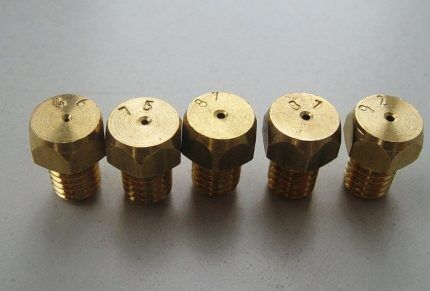
Older models of gas stoves do not have a nozzle. However, they are equipped with a mechanism that allows you to regulate the intensity of fuel supply. It needs to be configured correctly. Adjustment is carried out by turning the tap equipped with the gas cylinder.Without unscrewing the valve all the way, it is easy to reduce the gas pressure in the system and minimize the likelihood of soot appearing.
In some situations, soot appears when the oven is turned on. It is likely that the injector needs to be replaced here too. In most gas stoves, the nozzle is located behind the left wall of the oven chamber, into which the arc-curved burner is inserted. To replace the nozzle, you need to unscrew the screws, remove the burner, find and replace the part.
During prolonged use of a gas appliance, the jet could become stuck to the burner nozzle. In such a case, you need to lubricate it with a special compound and wait a few minutes.
When the nozzle is deformed, fuel flows unevenly to the burner, soot may appear and gas may accumulate in the device, which is dangerous. To replace the nozzle, you need to look at the brand of the gas stove and select the appropriate components.
It is important to remember that gas equipment is potentially dangerous, so in case of any breakdowns, it is advisable to invite specialists from the gas company with which you have contract signed for service.
Conclusions and useful video on the topic
The soot that appears when using a gas stove causes a lot of trouble. The reasons for this behavior of the burner can be different, but most often they are associated with the incorrect size of the nozzle hole. The video shows how to quickly replace the nozzle and ensure normal operation of the gas appliance:
When a gas stove smokes, you need to start diagnosing by checking whether the nozzle matches the fuel type. If everything is in order here, you should pay attention to the quality of the fuel. It is recommended to refill cylinders only at trusted organizations.In some cases, the appearance of soot is associated with a malfunction. To find a breakdown and properly repair it, you should invite a professional.
Have you recently solved a problem with a burner that started smoking? Tell us what caused the problem and how you dealt with it. If you want to supplement the material presented above or ask questions about the topic of the article to our experts and other site visitors, write your comments in the feedback block located below.



